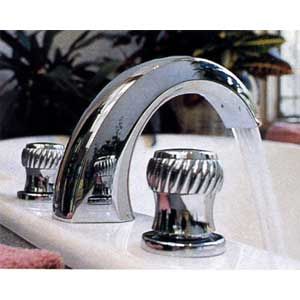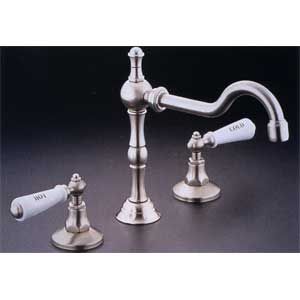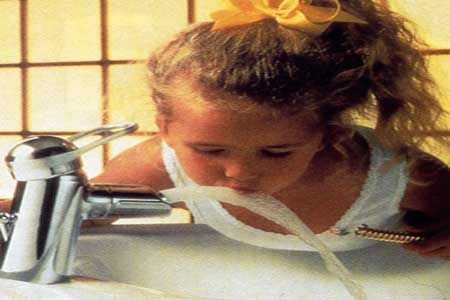We may be compensated if you purchase through links on our website. Our Reviews Team is committed to delivering honest, objective, and independent reviews on home products and services.
Faucets are essential fixtures in any home, serving both functional and aesthetic purposes. Whether you’re renovating your bathroom or simply replacing an old, worn-out faucet, understanding the key factors in faucet selection is important. This guide will explore the materials, finishes, types, and technologies that make up modern faucets, helping you make an informed decision for your home. From durable brass bodies to innovative valve systems, we’ll cover everything you need to know about choosing the right faucet for your needs.
Understanding Faucet Materials and Finishes
The longevity and appearance of your faucet largely depend on its construction materials and finish. Let’s explore the options available and their characteristics.
Solid Brass vs. Zinc Alloy Bodies
Faucet bodies are typically made from either solid brass or zinc alloy. Solid brass bodies are the gold standard for durability, especially in areas with hard water. These faucets resist corrosion and tend to last longer, but they come with a higher price tag, starting at around around $500*. Zinc alloy bodies offer a more budget-friendly option, usually beginning at $100 to $150. While they provide good durability, they may not withstand corrosion as well as brass over time.
*Costs in this article reflect an average of prices that our team found from hardware stores like Lowes and Home Depot, and on Amazon.com.
Popular Finishes and Their Durability
The finish of your faucet affects its appearance and maintenance requirements. Chrome remains a popular choice due to its durability and ease of cleaning. For a warmer look, consider brushed nickel or bronze finishes, which more effectively hide water spots and fingerprints. Matte black finishes have gained popularity for their modern aesthetic, while polished brass offers a classic look.
The Importance of Proper Plating
Plating plays an important role in protecting the faucet’s base material and enhancing its appearance. High-quality electroplated finishes, such as those found on chrome faucets, provide excellent durability. Some manufacturers offer proprietary finishes that claim to resist tarnishing and discoloration. For instance, Delta’s Brilliance finish and Moen’s LifeShine are designed to maintain their appearance over time, potentially reducing the need for frequent cleaning and maintenance.
Choosing the Right Faucet for Your Bathroom
Selecting the appropriate faucet involves considering both functionality and style. Here’s what you need to know about different faucet types for various bathroom fixtures.

Lav Faucets: Single-Handle vs. Double-Handle
Lavatory faucets come in single-handle and double-handle configurations. Single-handle faucets offer convenience and are often preferred for their ease of use, especially for children or those with limited dexterity. Double-handle faucets provide more precise temperature control and can complement traditional bathroom designs.
When choosing a lav faucet, consider the spread—the distance between the mounting holes on your sink. Common spreads include 4 inches for single-hole mounts and 6 to 8 inches for widespread faucets. Ensure your new faucet matches your sink’s configuration to avoid additional plumbing work.

Tub and Shower Faucet Options
Tub and shower faucets come in various styles to suit different setups. Wall-mounted faucets are common for combination tub-shower units, while deck-mounted options work well for freestanding tubs. Consider features like handheld showerheads for added versatility or multiple showerheads for a luxurious experience.

Specialized Faucets for Unique Needs
For users with specific requirements, there are faucets designed to meet various needs. ADA-compliant faucets (faucets compliant with the Americans with Disabilities Act) feature easy-to-use lever handles and are essential for accessible bathrooms. Touchless faucets, which activate with a wave of the hand, offer both convenience and improved hygiene, making them popular in both residential and commercial settings.
Inside the Faucet: Valve Technologies Explained
The heart of any faucet is its valve system, which controls water flow and temperature. Understanding these technologies can help you choose a faucet that meets your needs for durability and ease of maintenance.
Compression Valves: The Traditional Choice
Compression valves are the oldest type of faucet mechanism, commonly found in two-handle faucets. They use rubber washers to control water flow, which can wear out over time but are inexpensive and easy to replace. While not as popular in modern designs, they remain a reliable option for those who prefer traditional styling.
Ball Valves: Single-Handle Innovation
Ball valves, introduced by Delta in 1954, use a slotted metal or plastic ball to control water flow and temperature in single-handle faucets. They are known for their durability and relatively simple repair process. When choosing a ball valve faucet, opt for metal components over plastic for increased longevity.
Cartridge Valves: Easy Maintenance
Cartridge valves are found in both single and double-handle faucets. They offer smooth operation and are praised for their easy maintenance. When issues arise, the entire cartridge can typically be replaced quickly, making repairs straightforward even for DIY enthusiasts.
Ceramic Disk Valves: Modern Reliability
Ceramic disk valves represent the latest in faucet technology. They consist of two ceramic disks that slide against each other to control water flow. Known for their durability and resistance to mineral buildup, ceramic disk valves often come with extended warranties, reflecting manufacturers’ confidence in their longevity.
Advanced Features for Comfort and Safety
Modern faucets offer more than just water delivery. They incorporate features designed to enhance user comfort, safety, and efficiency.
Temperature Control Mechanisms
Scald prevention is a crucial safety feature, especially in homes with children or elderly residents. Pressure-balance valves maintain a consistent water temperature even when pressure fluctuates elsewhere in the plumbing system. Thermostatic valves go a step further, allowing users to set a precise temperature and maintain it throughout use.
Water-Saving Technologies
With increasing focus on conservation, many faucets now include water-saving features. Low-flow aerators reduce water usage without sacrificing performance, while WaterSense-certified models meet strict efficiency guidelines set by the Environmental Protection Agency (EPA). These technologies can help reduce water bills and environmental impact without compromising user experience.
ADA-Compliant Designs
ADA-compliant faucets are designed to be accessible to users with disabilities. Features may include lever handles that are easy to operate, touchless activation, and designs that allow for easy reach and control. These faucets not only meet legal requirements for accessibility but also offer enhanced usability for all users.
Shopping for Quality Faucets
Knowing where to shop and what to look for can help you find a high-quality faucet that meets your needs and budget.
Where To Find Reputable Faucets
Quality faucets are available through various channels, including home improvement stores, kitchen and bath showrooms, and plumbing supply houses. Online retailers also offer a wide selection, often with detailed product information and customer reviews. For expert advice and local support, consider visiting a plumbing wholesaler or consulting with a professional plumber.
How To Evaluate Faucet Quality
When assessing faucet quality, consider factors such as material composition, finish durability, and valve type. Look for solid brass construction in higher-end models and check for certifications like WaterSense for efficiency or from the National Sanitation Foundation (NSF) for material safety. Weight can be a good indicator of quality—heavier faucets often contain more metal and fewer plastic components.
Understanding Warranties and Support
Warranty coverage can vary significantly between manufacturers and models. Look for faucets with comprehensive warranties that cover both finish and function. Some high-end faucets offer lifetime warranties, reflecting the manufacturer’s confidence in their product. Additionally, consider the availability of replacement parts and customer support when making your decision.
Prominent Faucet Brands To Consider
The market is flooded with faucet brands, each claiming to offer the best in quality and design. Here, we highlight a few prominent brands known for their reliability and innovation.
Delta Faucets
Delta is renowned for its advancements in faucet technology, particularly its touchless and voice-activated models. The brand is also known for its distinctive MagnaTite docking, which ensures the spray wand stays in place. Delta’s commitment to water conservation is evident in its WaterSense-certified products, making them a top choice for eco-conscious consumers.
Moen Faucets
Moen offers a wide range of designs, from traditional to modern, ensuring there’s something for every bathroom style. The brand’s LifeShine finish guarantees that the faucet will not tarnish or corrode. Moen’s MotionSense technology enhances convenience and hygiene, making their touchless faucets popular in both residential and commercial settings.
Kohler Faucets
Kohler faucets are celebrated for their robust build and elegant designs. The brand frequently incorporates innovative features like temperature memory, which retains the previous water temperature setting, and ProMotion technology that allows smooth operation of faucet handles and spray heads. Kohler’s durability and sophisticated look make it a preferred choice among homeowners and professionals alike.
Hansgrohe Faucets
Hansgrohe is known for combining form and function in its faucet designs. The brand focuses on ergonomic designs and user-centric features like Select technology, allowing users to control water flow with a simple button press. Hansgrohe’s commitment to quality is reflected in their long warranties and use of premium materials.
Grohe Faucets
Grohe faucets stand out for their German engineering and precision. The brand’s SilkMove technology provides smooth handle operation, ensuring precise control over water temperature and flow. Grohe also emphasizes water conservation, with many of its models featuring EcoJoy technology to reduce water consumption without sacrificing performance.
Faucet Installation and Maintenance
Choosing a faucet is only part of the equation. Proper installation and regular maintenance are essential for ensuring your faucet performs well for years to come.
DIY Installation Tips
Many homeowners opt to install their faucets themselves, which can save on professional installation costs. It’s important to follow the manufacturer’s instructions carefully. Ensure you have all necessary tools, such as adjustable wrenches, plumbers tape, and a basin wrench. Turn off the water supply before starting, and carefully secure all connections to avoid leaks. If you’re replacing an old faucet, inspect the area for any signs of damage or corrosion and address these issues before installing the new faucet.
When To Call a Professional
While DIY installation can be rewarding, some scenarios require professional intervention. If you’re dealing with complex plumbing systems or making significant changes to your bathroom’s layout, it’s best to consult a licensed plumber. Professionals not only guarantee a high standard of work but also provide warranties for their services, adding an extra layer of security.
Regular Maintenance Steps
To keep your faucet in top condition, perform regular maintenance. Clean the aerator periodically to remove any mineral deposits that can affect water flow. Inspect seals and gaskets for signs of wear and replace them as needed. For touchless faucets, replace batteries according to the manufacturer’s recommendations to ensure consistent performance. Regular cleaning with non-abrasive cleaners will help maintain the finish.
Our Conclusion
Choosing the right faucet involves balancing functionality, durability, style, and budget. By understanding the materials, technologies, and features available, you can select a faucet that complements your bathroom’s aesthetics and meets your household’s needs.
